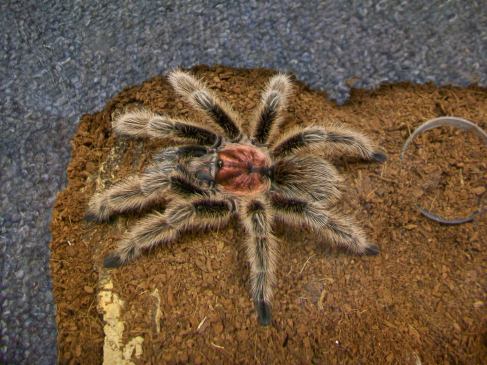Tarantula Tuesday: A Little Biology
Tarantulas are generally considered to be hairy, eight-legged behemoths that exist only in the tropical habitats (or people’s nightmares). But this is not the case! They are hardy creatures that are able to survive in a variety of habitats, from cloud forest to desert. We even have several species here in the United States, though they are mainly found in the Southwest.
To get Tarantula Tuesdays started off, I’ll give a bit of background on the biology of tarantulas, and next week I’ll start highlighting species. Tarantulas are arachnids, though not physically the largest (see here, with pics of one of the largest species being seen here). Some species do get very large though, with the Goliath bird eater (Theraphosa blondi) breaking 12 inches (30.5 cm) pretty easily. On the other end of the size spectrum though, are dwarf tarantulas, with species like the Trinidad dwarf tigerrump (Cyriocosmus elegans) stretching out to around 2 inches (5 cm).
A question I get a lot from people is “How poisonous are they?”. First off, tarantulas are venomous, not poisonous. The difference between those terms is that in order for something to be venomous, it has to actively inject the toxin into you (ex. spiders, snakes, scorpions). For something to be poisonous, you have to ingest it or come in contact with it (ex. mushrooms, some caterpillars). While tarantulas are venomous, it is generally not something that has to be worried about. Most people equate tarantula venom to bee venom (except in Old World species, which I will get into at a later date).
Since venom is biologically expensive to make, tarantulas do not like to use it unless they have to. Many species would rather kick off urticating hairs instead. Urticating hairs, when looked at under a microscope, look like this.
These hairs are built to irritate and boy, do they. I have gotten haired a couple times and it is uncomfortable. But it is not something that the tarantula will normally do unless disturbed. Many species will even try to run away first, but if their assailant keeps it up, the tarantula will start kicking hairs off. The video here shows a tarantula kicking off some hairs when disturbed (Notes: Handle tarantulas at your own risk! Also, I do not agree with the method of whoever made this video to get the tarantula to kick). The severity of the itching varies from species to species, though I have heard many people say that the hairs from a Goliath bird eater (T. blondi) are the worst.
Don’t worry, I’m not going to skip out on reproduction. That will be a post all in itself I think, since there is a lot to it, and because I’m waiting to see how things turn out with my first breeding project.
Citations:
“Tarantula Biology.” Tarantula Biology. N.p., n.d. Web. 12 Nov. 2013.
Schultz, Stanley A., and Marguerite J. Schultz. The Tarantula Keeper’s Guide. Hauppauge, NY: Barron’s Educational Series, 1998. Print.


That G. Rosea is beautiful!
Look familiar? Such a sexy male!